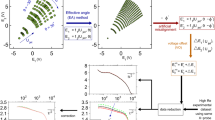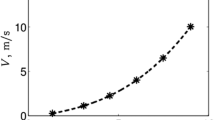Abstract
A method for in situ calibration of hot-wires in a turbulent flow is presented. The method is particularly convenient (even necessary) for calibrating large probe arrays, like the 143-wire boundary layer rake of the WALLTURB experiment. It is based on polynomial expansion of the velocity statistics in terms of voltage statistics as originally described by George et al. [Exp Ther Fluid Sci 2(2):230–235, 1989]. Application of the method requires knowing reference mean velocity and higher order central moments (with the array in place) of the turbulent velocity at the probe location at only one freestream velocity. These were obtained in our experiment by a stereo PIV plane just upstream of the probe array. Both the procedure for implementing the method and sample results are presented in the article.











Similar content being viewed by others
References
Breuer KS (1995) Stochastic calibration of sensors in turbulent flow fields. Exp Fluids 19(2):138–141
Bruun HH (1995) Hot-wire anemometry. Oxford University Press, New York
Citriniti JH, George WK (2000) Reconstruction of the global velocity field in the axisymmetric mixing layer utilizing the proper orthogonal decomposition. J Fluid Mech 418:137–166
Coudert S, Foucaut JM, Kostas J, Stanislas M, Braud P, Fourment C, Delville J, Tutkun M, Mehdi F, Johansson PBV, George WK (2007) Double large field stereoscopic PIV in a high Reynolds number turbulent boundary layer. Exp Fluids
Delville J (1994) Characterization of the organization in shear layers via the proper orhogonal decomposition. Appl Sci Res 53:263–281
Delville J, Fourment C, Tutkun M, Johansson PBV, George WK, Kostas J, Coudert S, Foucaut JM, Stanislas M (2007) High Reynolds number flat plate turbulent boundary layer experiments using a hot-wire rake synchronized with stereo PIV. In: Fifth international symposium on turbulence and shear flow phenomena, vol 1, pp 23–28
Delville J, Ukeiley L, Cordier L, Bonnet JP, Glauser M (1999) Examination of large-scale structures in a turbulent plane mixing layer. Part 1. Proper orthogonal decomposition. J Fluid Mech 391:91–122
George WK, Beuther PD, Lumley JL (1978) Processing of random signals. In: Proceedings of the dynamic flow conference, pp 757–800
George WK, Beuther PD, Shabbir A (1989) Polynomial calibrations for hot wires in thermally varying flows. Exp Ther Fluid Sci 2(2):230–235
Glauser MN (1987) Coherent structures in the axisymmetric turbulent jet mixing layer. Ph.D. dissertation, State University of New York, Buffalo
Iqbal MO, Thomas FO (2007) Coherent structure in a turbulent jet via a vector implementation of the proper orthogonal decomposition. J Fluid Mech 571:281–326
Johansson PBV, George WK (2006) The far downstream evloution of the high Reynolds number axisymmetric wake behind a disk. Part 1. Single point statistics. J Fluid Mech 555:363–385
Jung D, Gamard S, George WK (2004) Downstream evolution of the most energetic modes in a turbulent axisymmetric jet at high Reynolds number. Part 1. The near-field region. J Fluid Mech 514:173–204
Lumley JL (1970) Stochastic tools in turbulence. Academic Press, New York
Perry AE (1982) Hot-wire anemometry. Oxford University Press, New York
Tutkun M (2008) Structure of zero pressure gradient high Reynolds number turbulent boundary layers. Ph.D. dissertation, Chalmers University of Technology, Göteborg, Sweden. ISBN: 978-91-7385-166-4
Acknowledgments
The authors would like to thank P. B. V. Johansson and L. Jernqvist of Chalmers, F. Mehdi of University of New Hampshire, and P. Braud and C. Fourment of Laboratoire d’Etudes Aérodynamiques for their help for realization of the experiments within the Wallturb research program. This work has been performed under the WALLTURB project. WALLTURB (A European synergy for the assessment of wall turbulence) is funded by the CEC under the sixth framework program (CONTRACT No: AST4-CT-2005-516008).
Author information
Authors and Affiliations
Corresponding author
Rights and permissions
About this article
Cite this article
Tutkun, M., George, W.K., Foucaut, J.M. et al. In situ calibration of hot wire probes in turbulent flows. Exp Fluids 46, 617–629 (2009). https://doi.org/10.1007/s00348-008-0587-0
Received:
Revised:
Accepted:
Published:
Issue Date:
DOI: https://doi.org/10.1007/s00348-008-0587-0




